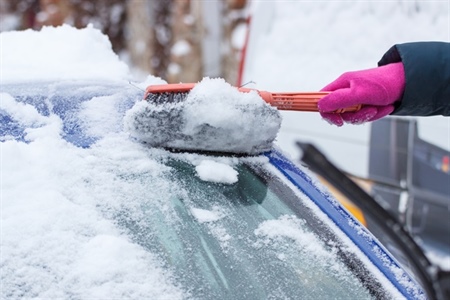How to Protect Your Auto Glass in Minnesota’s Harsh Winters

Minnesota’s intense winter weather can pose significant challenges to auto glass, making preventive measures crucial.
From freezing temperatures to frequent snow and ice, these conditions increase the likelihood of windshield cracks and damage, which can impact your car’s safety and visibility. Protecting your auto glass during these frigid months involves proactive care and using the right products to maintain its longevity.
In this guide, our team will cover key steps to help you shield your auto glass from Minnesota’s harsh winters and explore winter-specific products designed to protect auto glass from damage, ensuring your vehicle remains in top condition.
Steps to Prevent Windshield Cracks in Freezing Weather
Freezing weather can worsen windshield cracks, especially if there’s existing damage. One effective prevention method is parking in a garage or covered space, which reduces exposure to temperature extremes. When parking indoors isn’t possible, a quality windshield cover can help insulate the glass and prevent frost buildup.
Gradual defrosting is another essential practice. Avoid pouring hot water over your windshield to melt ice; the sudden temperature change can crack the glass. Instead, use your car’s defrost settings, starting at a low temperature and gradually increasing to avoid stressing the glass.
Maintaining proper windshield care through winter can be crucial. For minor chips or cracks, consider visiting professional auto glass repair services to prevent further damage, especially as temperature fluctuations can worsen even small imperfections.
How Cold Weather Impacts Auto Glass Longevity
Cold weather can accelerate wear and tear on auto glass, particularly due to expansion and contraction cycles caused by freezing temperatures.
As temperatures drop, glass becomes more brittle, increasing the likelihood of cracks when subjected to force or abrupt temperature changes.
Repeated exposure to cold weather without regular maintenance can also affect the glass seals, allowing moisture to seep in. This moisture can freeze and expand, potentially causing the glass to loosen or crack.
Using high-quality seals and inspecting them regularly helps maintain the glass’s integrity throughout the winter months.
Regular inspections and timely repairs are essential to preserve your windshield’s longevity in Minnesota’s extreme cold. Addressing even minor damage before winter can protect your auto glass against further, often costly, damage.
Best Types of Auto Glass for Cold Climates
Due to its resilience, laminated glass for front windshields performs particularly well in cold climates like Minnesota's. Made of two layers with a plastic interlayer, it is more resistant to cold-induced stress and prevents cracks from spreading quickly.
Another option for rear and side windows is tempered glass, which is treated to withstand impact and stress. While it shatters upon breaking, it’s less likely to develop small, stress-related cracks, which are common in winter. If replacement is needed, consider asking your auto glass technician about the benefits of laminated versus tempered glass in cold weather.
Impact of Ice & Snow Removal Methods on Auto Glass
Using the right tools and techniques when clearing ice and snow from your windshield can significantly reduce the risk of damage.
Plastic ice scrapers are generally safer than metal tools, which can scratch or chip the glass. To avoid direct impact on the glass, use the scraper along the edges, where damage is less likely to spread.
Soft-bristle snow brushes are ideal for snow removal, as they effectively clear the surface without scratching.
Avoid exerting too much pressure, especially if the glass is cold and more prone to cracking. Applying de-icing spray before scraping can help make ice removal easier and gentler on your windshield.
Being mindful of how you remove ice and snow protects the structural integrity of your auto glass, helping to prevent damage throughout the winter.
Winter-Specific Products to Protect Auto Glass
Several products are designed specifically to help protect auto glass during winter. Windshield treatments, such as hydrophobic coatings, repel water and reduce frost buildup, making it easier to clear ice. Applying these treatments in early winter provides additional defense for your windshield.
Windshield covers also prevent frost and ice from forming overnight, saving you time and reducing the need to scrape. Quality covers with insulated materials can even help maintain a stable temperature, minimizing the risk of cold-induced cracks.
Anti-fog and de-icing sprays further enhance visibility and protect the glass from extreme conditions.
Contact GlassWerks for Winter Glass Guidance
Got more questions about how to protect your auto glass in the winter time? Reach out to us!
Our experienced auto glass technicians are happy to answer any questions you have about auto glass best practices, safety features, repairs, replacements, and more.
Schedule a glass check or contact us whenever you need fast, you can also call our Glass Werks office so we can discuss our comprehensive professional auto glass repair services.